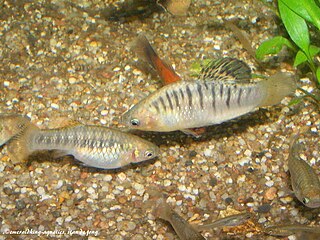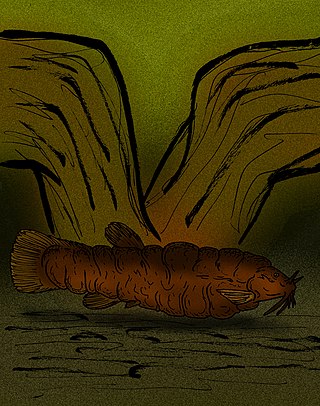
Poecilia is a genus of fishes in the family Poeciliidae of the order Cyprinodontiformes. These livebearers are native to fresh, brackish and salt water in the Americas, and some species in the genus are euryhaline. A few have adapted to living in waters that contain high levels of toxic hydrogen sulfide and a population of P. mexicana lives in caves.

The Monito gecko is a lizard, a species of gecko endemic to the island of Monito, in the archipelago of Puerto Rico.

Limia is a genus of livebearing fishes belonging to the Cyprinodontiform family Poeciliidae, which includes other livebearers such as platys, swordtails, guppies and mollies. They are found in fresh and brackish water. Of the 21 described Limia species, 17 are endemic to Hispaniola, one is found on both Hispaniola and Jamaica, and the Cayman Islands, Cuba, and Venezuela have an endemic species each. Limia are popular in aquaria among more advanced hobbyists.

Amaranthus brownii was an annual herb in the family Amaranthaceae. The plant was found only on the small island of Nihoa in the Northwestern Hawaiian Islands, growing on rocky outcrops at altitudes of 120–215 m (394–705 ft). It was one of nine species of Amaranthus in the Hawaiian Islands, as well as the only endemic Hawaiian species of the genus. It is now considered extinct.

The humpbacked limia or black-barred limia is a critically endangered species of poeciliid fish which is endemic to Haiti. Its common name is derived from the hump males develop as they age. It is sometimes kept in home aquaria.

Limia perugiae, or Perugia's limia, is a poeciliid fish endemic to the Caribbean island of Hispaniola. It is one of the most widespread species in the Limia genus, inhabiting waters ranging from fresh to hypersaline.

Rhizosomichthys totae is a species of catfish of the family Trichomycteridae, and the only species of the genus Rhizosomichthys. This fish grew to about 13.8 centimetres (5.4 in) and was endemic to Colombia where it occurred in the Lake Tota basin. It is listed as a critically endangered species by the IUCN Red List. The species was last seen in 1957, and only 10 specimens were found. The disappearance is possibly linked to the release of 100,000 imported rainbow trout eggs into Lake Tota in 1936.
Rhinella amabilis is a species of toads in the family Bufonidae that is endemic to Ecuador, only occurring in a severely fragmented area less than 100 square kilometres (39 sq mi).
The Andean catfish is a species of freshwater fish in the family Astroblepidae. The Spanish name for the Andean catfish is preñadilla. It is endemic to the highlands of the Ecuadorian Andes where it lives in mountain streams in four different drainage basins in the Imbakucha watershed. It is a brownish-grey fish growing to about 150 mm (6 in). The fish is threatened by human activities in the area with loss and fragmentation of its habitat, and the International Union for Conservation of Nature has assessed its conservation status as being "critically endangered".
Clermontia oblongifolia is a species of flowering plant in the bellflower family known by the common name Oahu clermontia. It is one of several Hawaiian lobelioids in genus Clermontia that are known as ʻoha wai. This plant is native to three of the Hawaiian Islands, where one subspecies is not uncommon but the other two are very rare and endangered.

The wildlife of Haiti is important to the country because of its biodiversity. According to the World Conservation Monitoring Centre, Haiti is considered to be "one of the most biologically significant countries of the West Indies". With an estimated 5,600 plant species on the island of Hispaniola, some of which only occur in Haiti, 36% are considered as endemic to the island. A mountainous area country, it is situated in the western three-eighths of Hispaniola and shares a border with the Dominican Republic. There are nine life zones, from low desert to high cloud forests, as well as four mountain ranges, and hundreds of rivers and streams and the coral reefs in the seas that surround the islands. Issues of environmental damage, expanding population, deforesting and erosion are of concern; less than 2% of the original forest remains on account of deforestation. This degradation is traced from the 17th century to 19th century starting with the French colonization of the Haiti and population explosion during the 20th century and for the purpose of forestry and sugar-related industries, degraded the forests. and the environment.

Haplochromis vonlinnei is a species of cichlid endemic to Lake Victoria. It is greyish in color with a distinct mid-lateral band, and a rather slender shape. It feeds mainly on smaller fish. This species can reach a length of 15.9 centimetres (6.3 in) SL. The population of the species has declined due to the introduction of the Nile perch in the 1950s. It has not been recorded since 1980 and the IUCN lists it as "Critically Endangered" and considers it may already be extinct. This fish is named in honour of the Swedish naturalist, Carl Linnaeus.

Poecilia mexicana, commonly known as the shortfin molly or Atlantic molly, is a species of poeciliid fish native to fresh and brackish water in Mexico and Guatemala. One population is found in caves and known as the cave molly.
Limia melanonotata, the blackbanded limia, is a toothcarp in the family Poeciliidae. It is endemic to the island of Hispaniola.

The Hispaniolan gambusia is a fish endemic to the island of Hispaniola.

Limia sulphurophila, also known as sulphur limia, is a livebearing fish in the family Poeciliidae. It is endemic to the Dominican Republic in the island of Hispaniola.

Limia islai, also known as the tiger limia, is a species of fish within the family Poeciliidae. This species is one of several Limia that are endemic to Lake Miragoâne, Haiti.

Limia melanogaster, the black-bellied or blue limia, is a poeciliid fish from Jamaica. It inhabits fast-flowing streams. It is a rare livebearer in modern fishkeeping.

Limia tridens, commonly known as the Tiburon limia, is a poeciliid fish endemic to the Caribbean island of Hispaniola.
Limia fuscomaculata, also called the blotched limia, is a critically endangered poeciliid fish endemic to Haiti.














